Lille faced Valencia in the third matchday of the UEFA Champions League on Wednesday night. Both teams seemed to be in a similar form as of late with both failing to keep their consistency in their respective leagues.
The hosts came into the match following a poor showing at Toulouse, resulting in a disappointing 2-1 loss in Ligue 1. This put them down to seventh place in the Ligue 1 table. Valencia, meanwhile, managed to give a strong performance away against Atletico Madrid as they managed to hold the hosts to a 1-1 draw. However, despite their impressive showing, they were unable to get the full three points from the solid side of Diego Simeone.
Despite the fairly low confidence in the Lille side currently, as they haven’t been able to win any of their last four matches before the game, Lille had to quickly pick themselves up as their season is still really far from finished. It can get better or worse from here. The same also goes for Valencia as they seemed to be unable to keep a consistent showing since the start of the season.
In this tactical analysis, we’ll take a closer look at the tactics set up by both sides for this UEFA Champions League clash.
Lineups
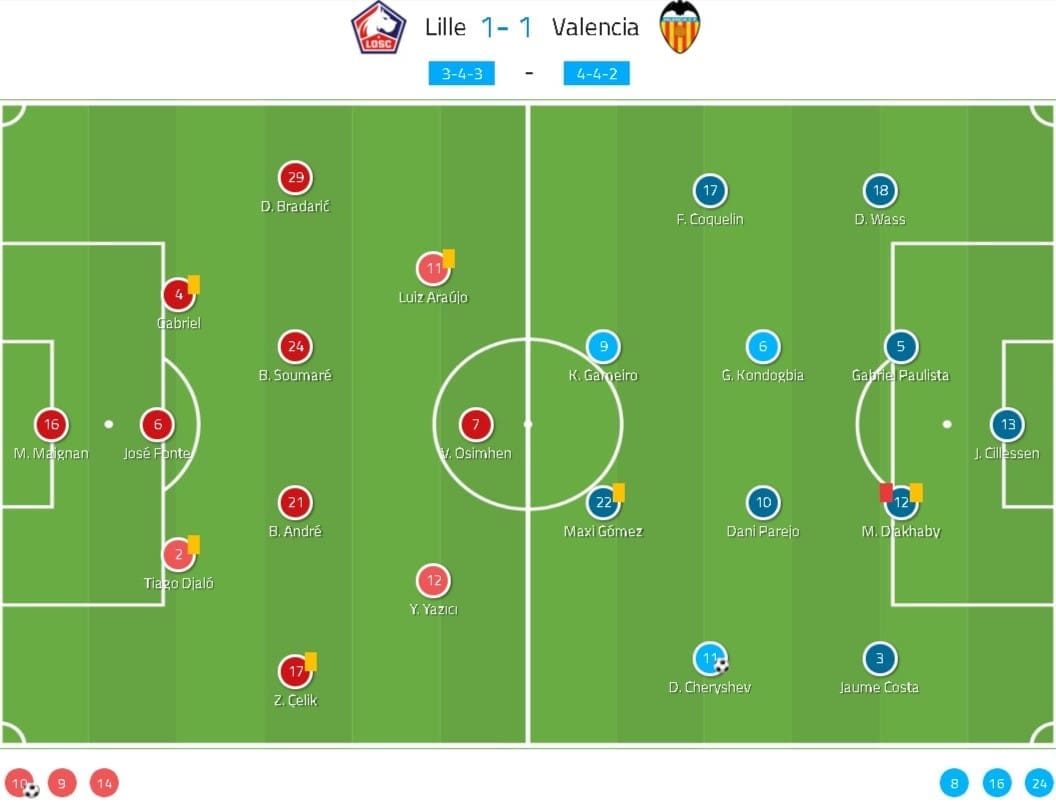
Christophe Galtier deployed his side in a rather unusual system of 3-4-3 despite usually rotating only around 4-2-3-1 or 4-4-2. The French manager might be looking to bring some elements of surprise by going with this unfamiliar setup. Tiago Djaló came back into the starting lineup having regained full fitness. Zeki Çelik also came back into the starting XI, replacing Jérémy Pied.
Meanwhile, experienced midfielder Benjamin André replaced deep-lying playmaker Xeka who had an abysmal performance against Toulouse the last time out. The former Rennes man partnered up with wonder kid Boubakary Soumaré in the middle of the field.
Luiz Araújo and Victor Osimhen kept their place upfront while Jonathan Ikoné and Jonathan Bamba were relegated to the bench. Yusuf Yazici started in this match instead, playing on the right side of the wing.
Albert Celades, on the other hand, used his favourite system of 4-4-2 in this match.
There were only two changes of personnel that can be seen in the lineup. Both Ezequiel Garay and Ferran Torres started the game on the bench while Frenchmen Mouctar Diakhaby and Kevin Gameiro came into the starting 11 for this game.
Valencia struggling against Lille’s aggressive defence
The guests looked to be quite patient when in possession earlier in the game. However, they soon realized they need to switch the gear up to be able to escape Lille’s high defensive block and very aggressive pressure.
Lille seemed to set their block in a 3-4-3 shape as can be seen in the picture below.
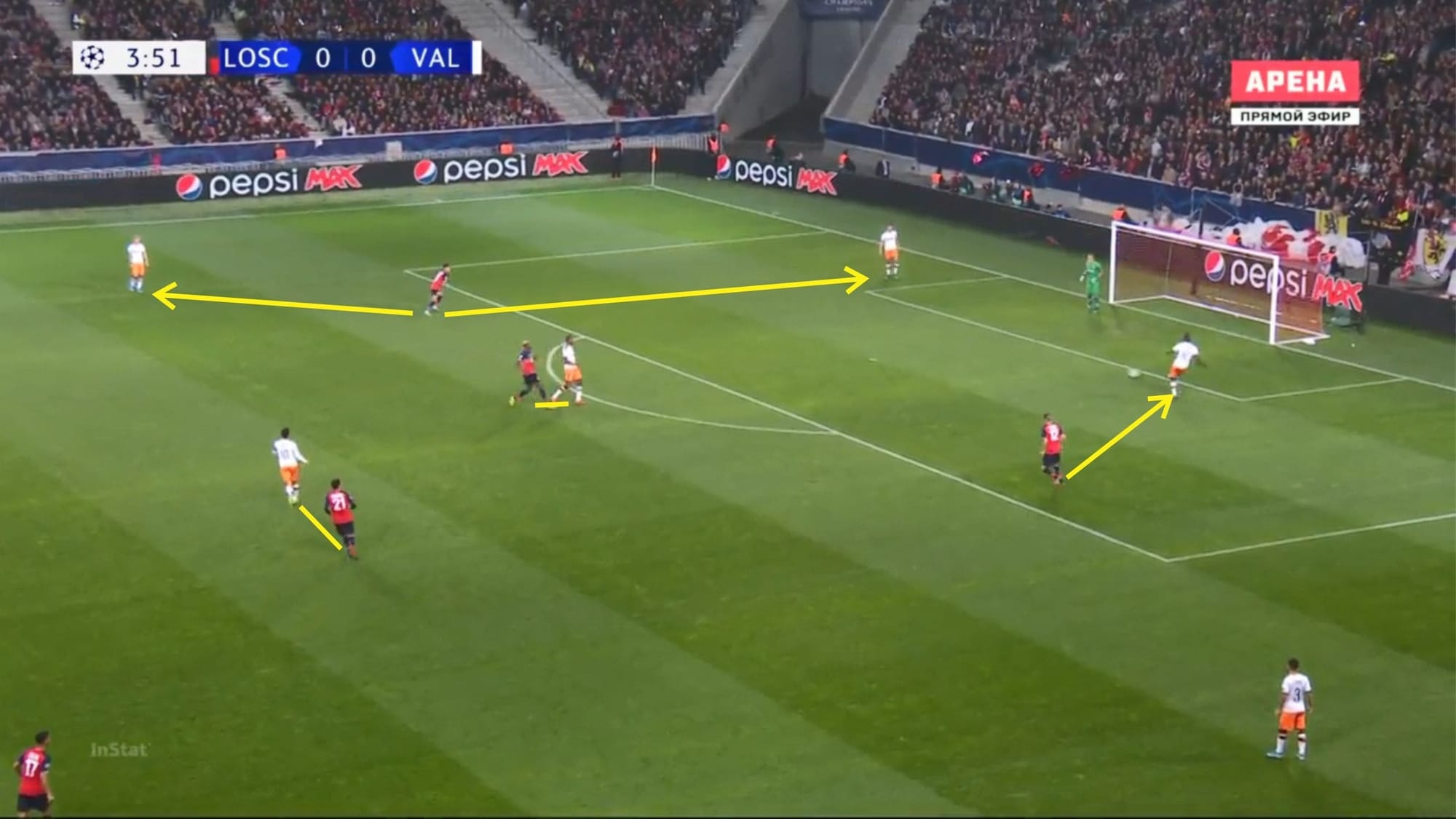
From this picture, we can see that Lille were aiming to both mark the passing lane (positional/zonal) as well as marking the passing option (man for man). Osimhen and André marked Geoffrey Kondogbia and Dani Parejo respectively.
Araújo positioned himself in between Daniel Wass and Gabriel Paulista in anticipation if a pass was played towards either of those two. The Brazilian winger will try to press the intended passing target once the ball was played towards him.
Yazici, meanwhile, will try to close down Diakhaby whilst also blocking his access towards the left-back. With access to the two pivots also blocked, Diakhaby’s closes options were Wass and Gabriel. However, as mentioned before, those two were in danger of being under pressure deep in their own half once the ball’s played towards either of them.
When Valencia managed to play their way out of pressure, Lille set up a medium block with the shape of 5-4-1. The wing-backs dropped back and covered the width while the wingers dropped into a four-man midfield and defended very narrowly. This can be seen from the picture below.
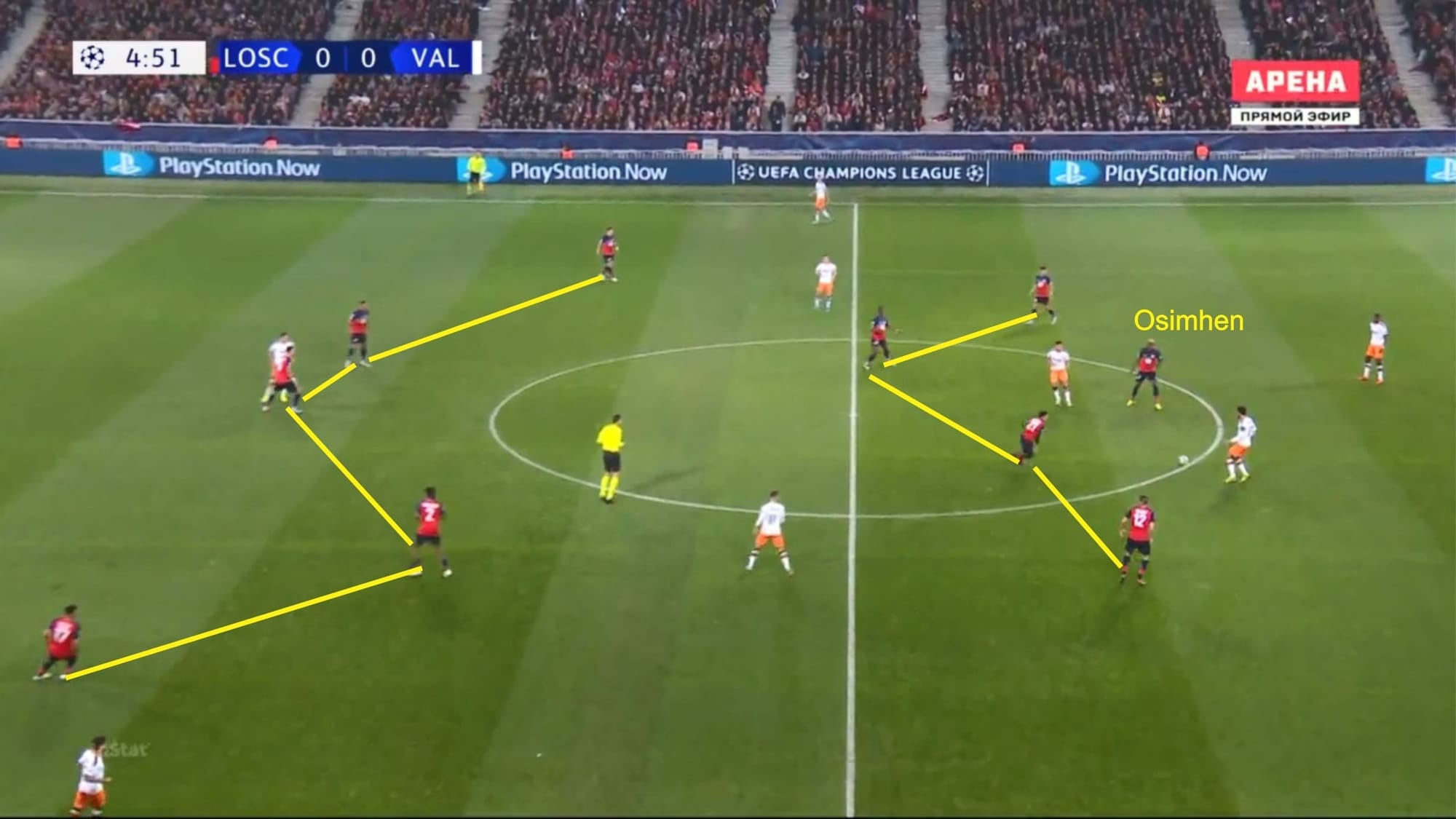
This way, they were able to cover the width whilst also crowding the midfield to make it difficult for Valencia to pass through, knowing that Celades’ side tended to combine through the middle and breakthrough centrally as can be seen in this picture below. Of course, with the intense pressure from Lille, Valencia needed to really move the ball quicker when playing through the middle by taking fewer touches as mentioned previously in this tactical analysis.
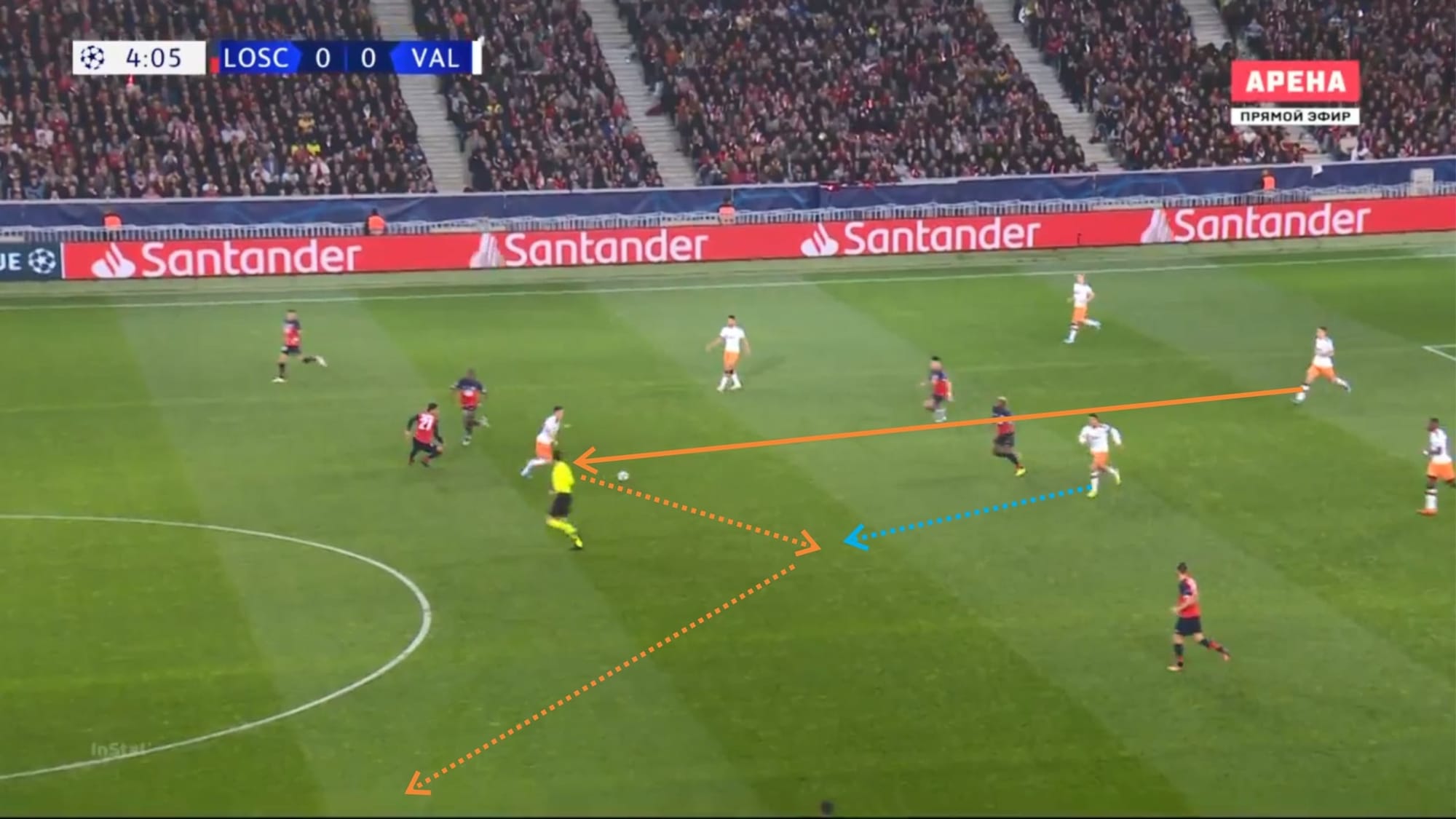
This high block was very effective and Valencia were really struggling to break out of the pressure for most of the game. The fact that Valencia lost the ball 26 times in their own half (the highest amount of possession loss in own half this season) is very good evidence of how aggressive yet effective Lille’s defensive tactics were. This number is actually similar to when Valencia faced Getafe (who are well-known to be extremely aggressive in defence) with Los Ches losing the ball in their own half 25 times throughout the game.
However, due to Lille’s high defensive line and exposed backline, at certain times this high blocking and aggressive pressing could also cause them danger. Especially if they were slow in transition. Galtier’s side were actually very disciplined and organized in the first half. However, it’s a different story in the second half.
In fact, Valencia’s only goal of the game was the result of a quick counter-attack which was clearly successful mainly due to Lille players being too slow and indisciplined when transitioning to defence in the second half. The middle of the pitch was exposed with Soumaré and André nowhere to be found and Maxi Gómez exploited this by dropping deep and delivering a first-time through pass towards Gameiro who made an inward diagonal run from out wide. The French forward delivered a pass across the goal towards Denis Cheryshev and the winger calmly slotted the ball in.
Celades’s side seemed to be forced to rotate the ball quicker and play somewhat more direct due to Lille’s defensive tactics.
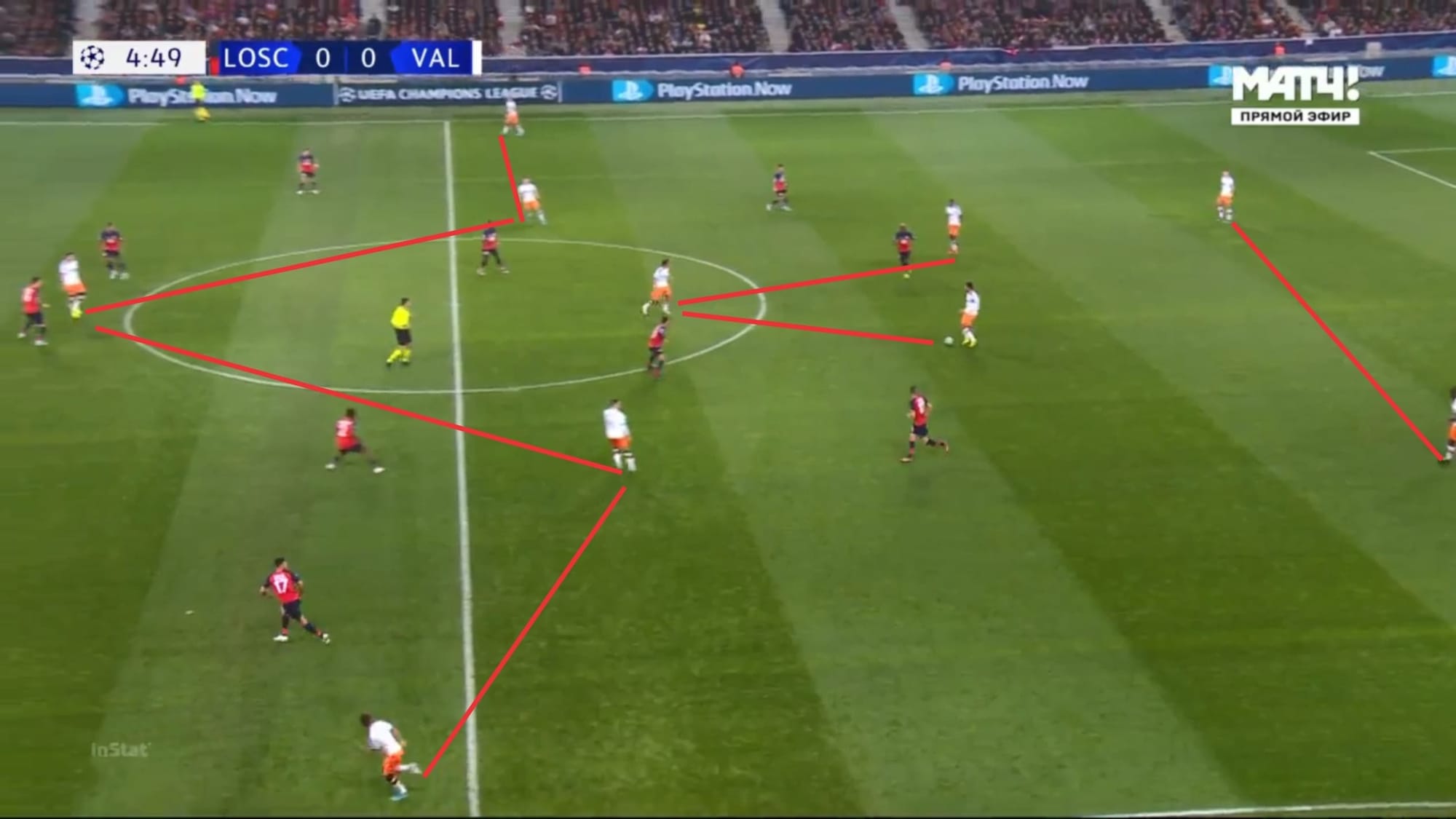
They seemed to try to create a 2-3-5 shape when in attack.
Though Francis Coquelin seemed to start as a right midfielder in the lineup, he tended to sit most often in the half-space and played more centrally.
The two full-backs can be seen sitting very high and wide to stretch the opposing defence. Gameiro and Cheryshev, meanwhile, sat most often in the half-space and dropped very frequently to provide passing options as well as drag the defenders out of position.
With their attacking numbers matching Lille’s defensive personnel (5v5), Valencia often found it very hard to break through the defence and find free space in the backline. The fact that Los Ches only managed to get six shots throughout the game (three on target) means that Valencia didn’t often get chances in this game.
Lille dominate possession but lacks effectiveness
Galtier’s side looked to dominate the game by keeping most of the possession throughout the game.
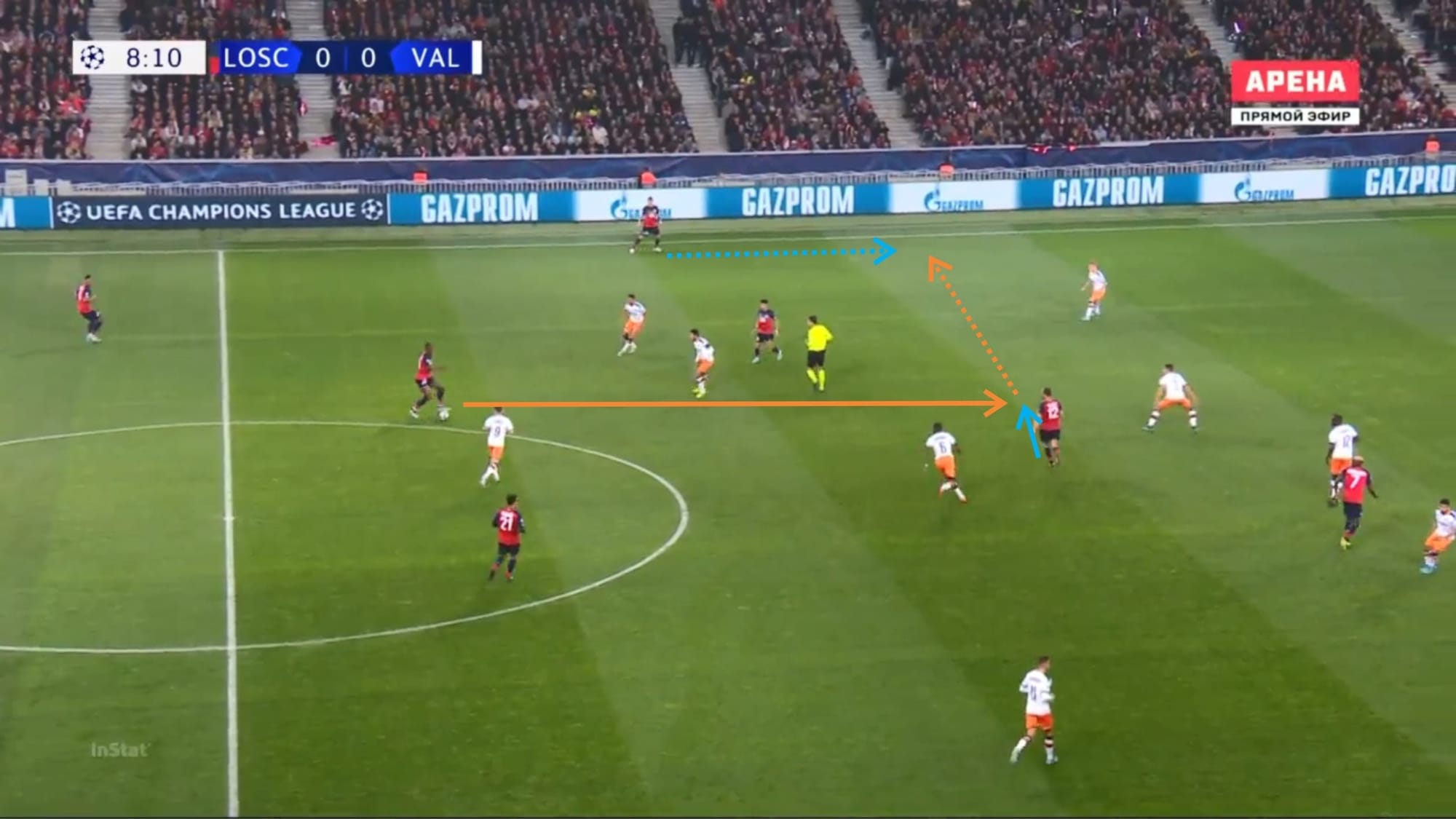
Their attacking style clearly differed from their opposition’s. While the guests looked to play through the middle and breakthrough centrally, the hosts would try to progress through the half-space and exploit the flanks.
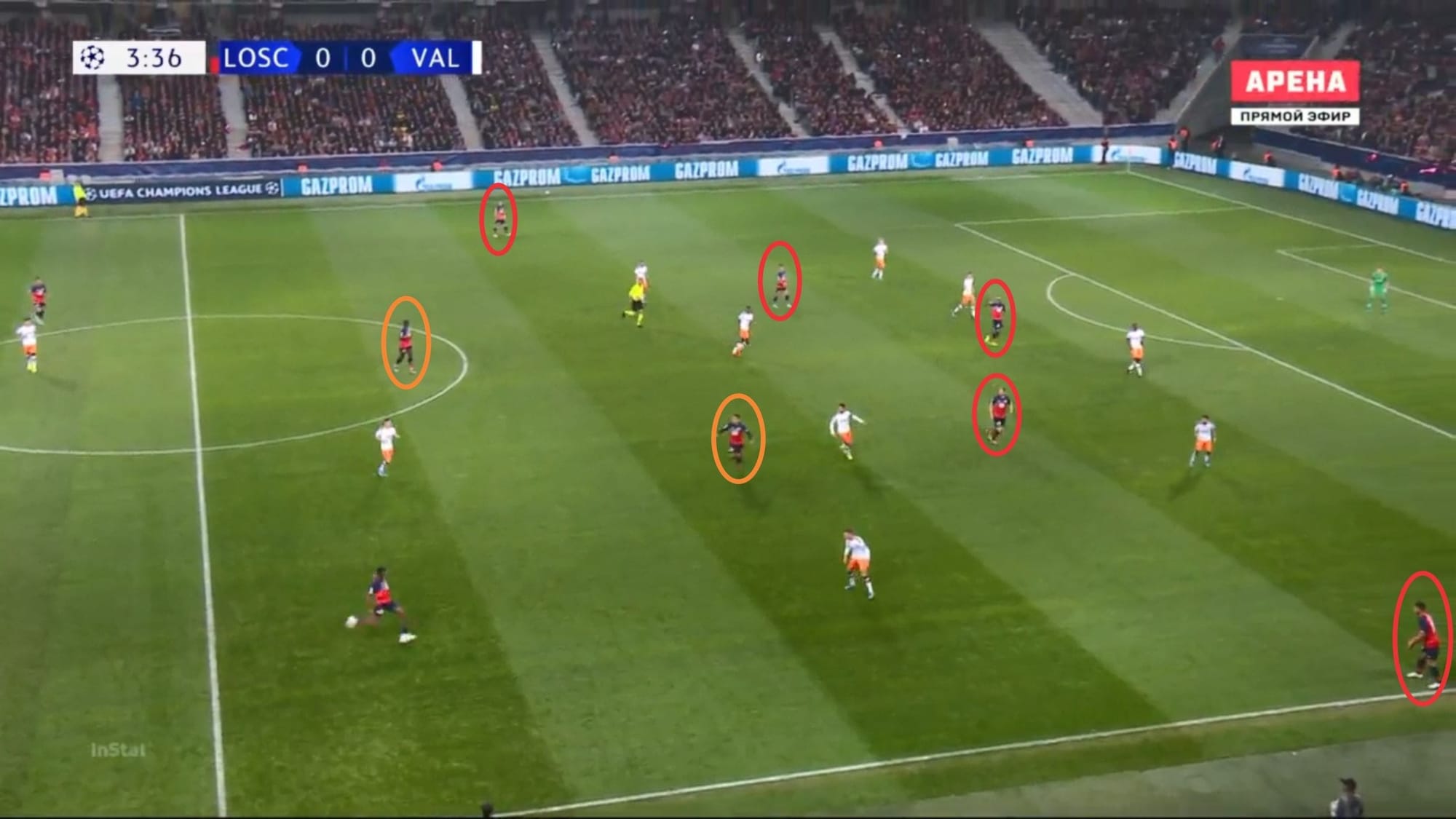
Lille seemed to create a 3-2-5 attacking shape. The two orange circles in the middle were Soumaré and André acting as a double pivot. The two centre-mids aimed to be the first pass in midfield as well as recycle possession and distribute the ball towards more creative players when in attacking phase. Both were also tasked to anticipate the opposition counter-attacks and were also very active in defence.
As you can also see, the two wing-backs sat high and wide in an attempt to stretch the defence and pose some threat on the flanks. The two wingers, on the other hand, played more narrowly. Lille seemed to successfully create numerical superiority up front as they had five players going against four in Valencia’s backline.
This was no doubt a very smart move by Galtier and these tactics clearly worked well as Lille managed to get through Valencia’s defence numerous times and create some dangerous chances. Their 24 attempts on goal as well as 69 entrances to final third and 31 entrances to Valencia’s box were very clear indicators of how well they were at breaking through the defensive line and creating chances.
However, again, they were really ineffective in front of goal as they only managed to get six shots on target (25%). Lille also managed to record a total of 1.69 xG in this game while only scoring a goal which also shows that they were able to get good quality shots in high xG areas, but weren’t always able to convert them.
Lille tended to start from deep with a short distribution from the goalkeeper and played rather patiently at the back. But once they managed to enter the opposition half, they seemed to increase their urgency and moved the ball around as well as rotated positions much quicker. Perhaps this can also be attributed to Valencia’s fairly aggressive pressing and very tight and narrow defence.
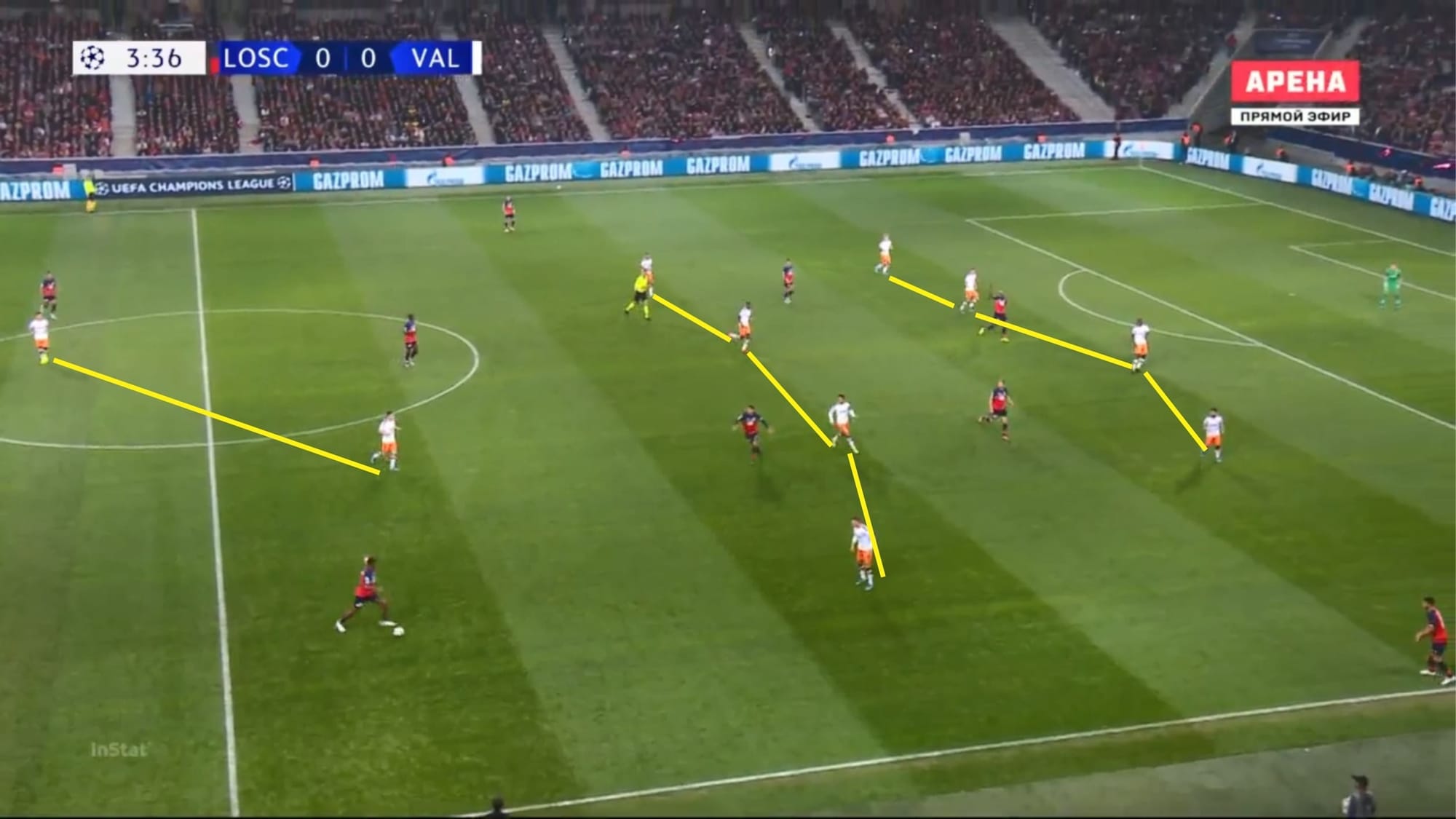
As you can see in the picture above, Valencia set up two banks of four in defence. You can also see that they were quite narrow both vertically and laterally. This was to deny Lille time and space in their half. When the ball was played towards the flanks, the block would quickly move and try to create an overload on one side as can be seen in the picture below.
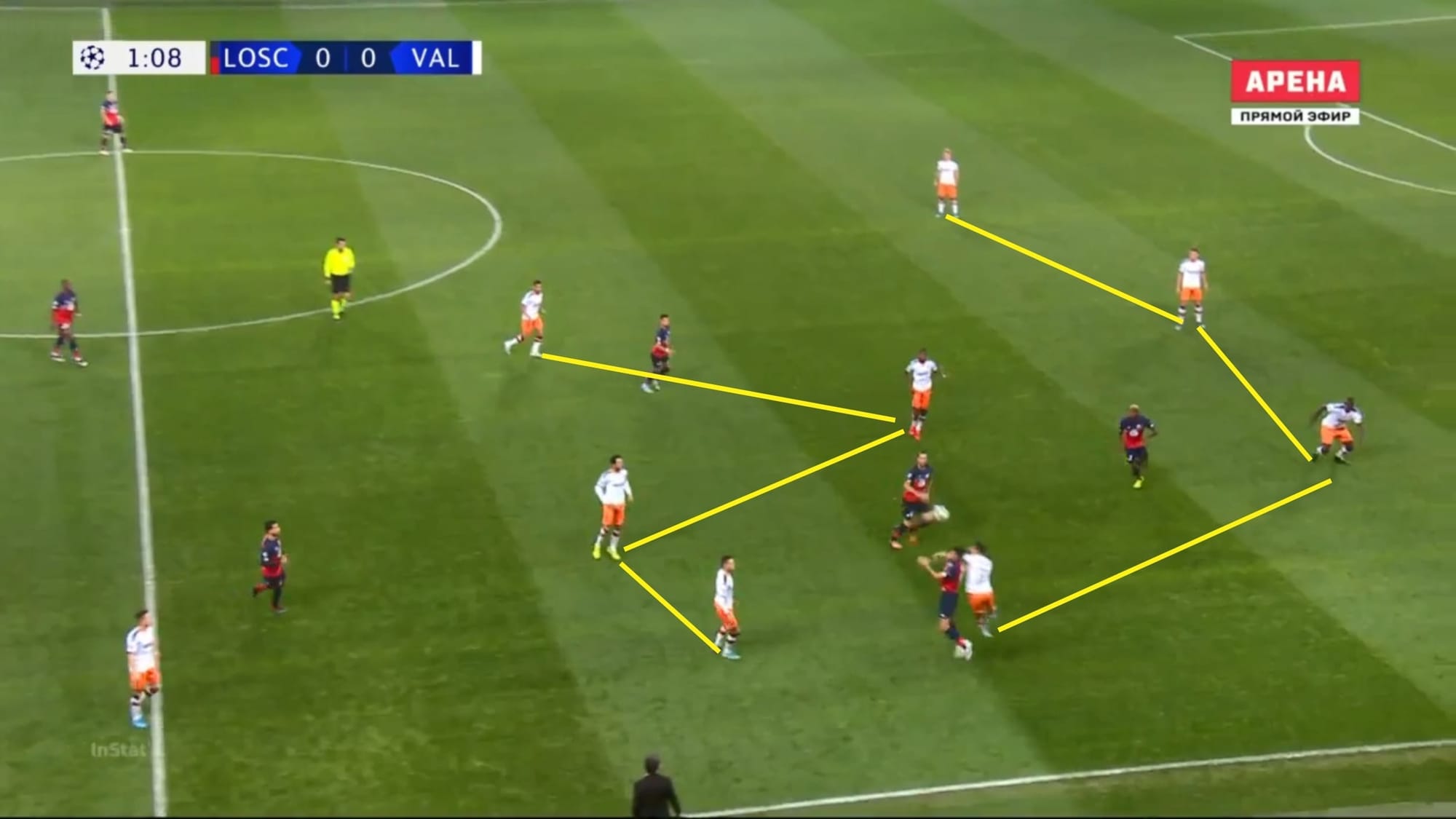
From the picture above you can clearly see that despite Valencia being numerically superior and successfully compressing space on the flank, there was an abundance of space on the other side of the pitch. That certainly could be very dangerous if Lille successfully escaped the pressing trap and switched play.
Valencia seemed to be quite quick and disciplined when moving their block throughout the game though and this made it very difficult for Lille to attack from the flanks. This also seemed to force them to combine quicker when out wide to avoid the pressure.
Conclusion
To conclude this tactical analysis, the last season’s Ligue 1 runner-ups were able to dominate the game at Stade Pierre-Mauroy. However, they were unable to make the most out of their possession and chances. Valencia, meanwhile, didn’t have a lot of opportunities coming their way, but they kept working hard for it and seemingly much more decisive in front of goal despite having very few shots on goal.
Lille’s defensive tactics seemed to already be the perfect medicine for Valencia’s attacking tactics. However, due to the risk of being disorganized and the exposed backline, Lille needed to really execute the plan perfectly and in a disciplined manner throughout the full 90.
Lille’s late goal through Ikoné were hard to swallow for Valencia who really struggled hard to keep Lille at bay. But surely a goal was going to come though judging by how many chances the French side managed to create in the game.

If you love tactical analysis, then you’ll love the digital magazines from totalfootballanalysis.com – a guaranteed 100+ pages of pure tactical analysis covering topics from the Premier League, Serie A, La Liga, Bundesliga and many, many more. Buy your copy of the October issue for just ₤4.99 here





Comments